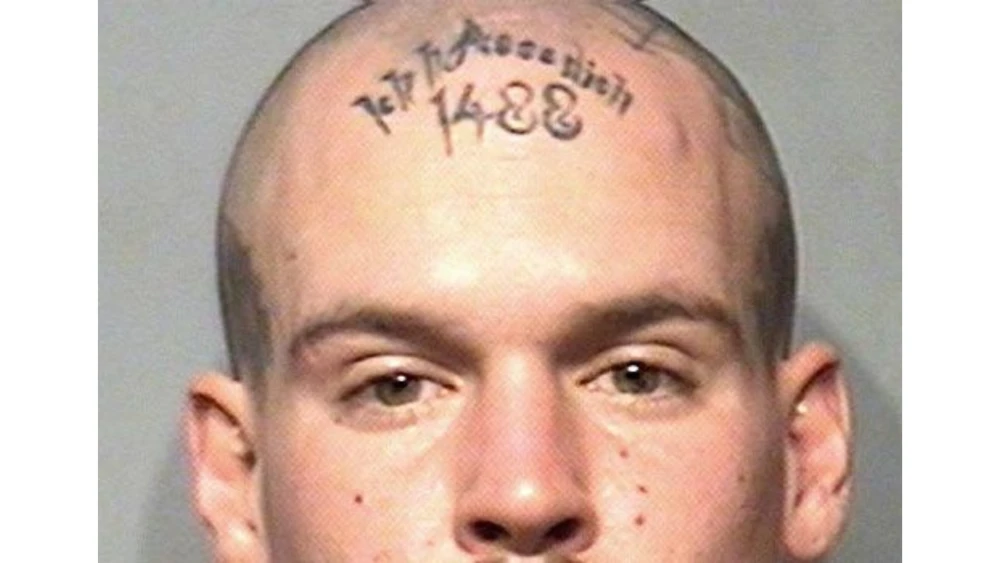
The complex world of corrections presents unique challenges, with the safety and security of both inmates and staff at the forefront of every decision. One crucial aspect of maintaining order within prison walls is the ability to understand the visual markers that inmates use to convey their affiliations, beliefs, and even criminal histories.
Tattoos, in particular, serve as powerful symbols that can offer valuable insights to correctional officers. By deciphering the meanings behind these intricate designs, staff can enhance their situational awareness and better protect themselves and their colleagues from potential threats or incidents.
In the following list, we will explore 15 common prison tattoos and their associated meanings, providing a glimpse into the complex language that inmates use to communicate and assert their identities within the confines of the prison system.
1. The 1488 Tattoo: Symbol of White Supremacy

The number 1488, or its components 14 and 88, commonly adorns white supremacist inmates. Originating from a quote by Nazi leader David Lane, this tattoo signifies a commitment to racial purity and the ideals of Nazism. Understanding its significance can help identify potential threats within the inmate population.
2. The Cobweb: Sign of Incarceration

A cobweb tattoo often indicates a lengthy prison term, reflecting the notion of being trapped, much like prey in a spider’s web. Typically found on elbows, it symbolizes prolonged confinement and a sense of entrapment within the criminal justice system.
3. The Teardrop: Mark of Violence or Loss

Among the most recognizable prison tattoos, the teardrop’s meaning varies regionally. It can signify a long prison sentence, a history of violence, or even mourning for a lost comrade. Recognizing its diverse interpretations is essential for gauging an inmate’s background and potential risk factors.
4. The Five-Point Crown: Emblem of Gang Affiliation

Sported by members of the Latin Kings gang, the five-point crown symbolizes allegiance to one of the largest Hispanic gangs in the U.S. Its presence, often accompanied by the acronym ALKN, serves as a clear indicator of gang affiliation and potential involvement in criminal activities.
5. The Three Dots: Representation of “Mi Vida Loca”

A ubiquitous prison tattoo, the three dots signify a life of chaos and unpredictability. While not tied to a specific gang, it reflects a broader adherence to the gang lifestyle and its inherent risks. Understanding its significance aids in identifying individuals entrenched in the criminal subculture.
6. The Clock With No Hands: Symbol of Incarceration

Depicting a clock without hands, this tattoo metaphorically represents the timeless nature of imprisonment. Often worn by those serving lengthy sentences, it serves as a stark reminder of time lost within the confines of the penal system.
7. Aryan Brotherhood Tattoos: Markings of Hate and Violence

Tattoos associated with the Aryan Brotherhood, including swastikas and SS bolts, denote allegiance to one of the most notorious prison gangs. Recognizing these symbols is crucial, as members are often responsible for a disproportionate amount of violence behind bars.
8. Norteño Tattoos: Affiliation with Northern California Gangs

Representing the Nuestra Familia gang, Norteño tattoos symbolize allegiance to Hispanic gangs in Northern California. Understanding these markings aids in distinguishing between rival factions and mitigating potential conflicts within correctional facilities.
9. La Eme Tattoos: Sign of Mexican Mafia Influence

La Eme, or the Mexican Mafia, wields considerable influence within the prison system. Its symbols, such as the letter M, serve as identifiers for members of this powerful criminal organization. Awareness of these tattoos is essential for countering their illicit activities.
10. MS 13 Tattoos: Emblem of Ruthless Criminality

Originating from El Salvador, MS 13 tattoos signify membership in one of the most notorious gangs in the U.S. Their presence, often in prominent locations, underscores the gang’s pervasive influence and propensity for violence.
11. Playing Cards: Sign of a Gambler

Tattoos depicting playing cards or card suits indicate an inmate’s affinity for gambling. In addition to recreational activities, they may also symbolize a willingness to take risks and embrace uncertainty—a trait prevalent in the criminal underworld.
12. EWMN: Representation of Aggression

The acronym EWMN, meaning “Evil, Wicked, Mean, Nasty,” conveys a sense of menace and hostility. Found on the knuckles of some inmates, it serves as a warning to others and highlights the individual’s confrontational demeanor.
13. Cross on the Chest: Symbol of Criminal Authority
In Russian prisons, a cross tattooed on the chest signifies a “Prince of Thieves,” denoting a high-ranking figure within the criminal hierarchy. Understanding these cultural nuances is essential for grasping the dynamics of inmate social structures.
14. A.C.A.B.: Expression of Anti-Authoritarianism

The acronym A.C.A.B., commonly seen on British prisoners, expresses disdain for law enforcement and authority figures. Its presence, often on the knuckles, signals defiance and solidarity with fellow inmates.
15. The Five Dots: Symbol of Incarceration

Distinct from the three-dot tattoo, the five dots carry a specific significance within the prison subculture. Also known as the quincunx, this tattoo represents time spent behind bars, with each dot symbolizing a wall and the fifth dot representing the inmates themselves. Understanding the symbolism behind the five dots aids in identifying individuals with extensive prison histories and potential affiliations with criminal organizations.



